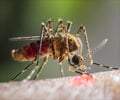
‘A correlation between the neurological complications caused by the zika virus and high levels of Gas6, a protein that helps the virus invade human cells is discovered.’
Tweet it Now
According to the Ministry of Health in Brazil, more than 2,006 probable cases were notified in January-May 2021.The rise in zika cases was accompanied by an increase in cases of microcephaly, a rare neurological disorder in which the fetal or newborn’s brain fails to develop completely.
More than 2,400 cases of microcephaly were notified in Brazil in 2015, compared with 781 in the previous five years.
Although zika is usually asymptomatic, recent data shows a link between the disease and the development of neurological complications such as Guillain-Barré syndrome, encephalitis and meningitis in adults, and congenital malformations such as microcephaly in infants.
It has been shown that zika virus can cross the blood-brain barrier and also enter the placenta, where it infects the fetus.
Advertisement
To find out how Gas6 levels correlated with the neurological complications associated with zika, the researchers used the ELISA enzyme-linked immunoassay to analyze blood samples from patients included in a cross-sectional study conducted between February 2016 and June 2017 in hospitals in Campinas, state of São Paulo.
Advertisement
The “neuro” group had higher levels of Gas6 and SOCS-1.
Meanwhile, another group of researchers was working with adult mice bred at the university with an immune system capable of combating the virus.
“We inoculated the virus with and without Gas6 into pregnant and non-pregnant mice. Viral load on the first day after infection was much higher in the adult mice that received the virus with Gas6, showing that the protein favors infection. A high proportion of their offspring had congenital malformations, with smaller heads and lower overall size,” said Lilian Gomes de Oliveira, joint first author of the article with João Luiz da Silva Filho.
To invade monocytes by binding to cell receptors, Gas6 must undergo a chemical reaction that enables it to interact with other molecules.
Based on this fact, researchers tested in vitro use of a drug that inhibits carboxylation (warfarin), which did indeed block or reduce viral replication.
By explaining the mechanism behind neurological complications in zika virus, researchers have opened up the possibility of further research that could serve as a basis for intervention with drugs.
These findings also contribute to a better understanding of the pathogenesis of severe zika and its outcomes and point in the direction of studies in pursuit of ways to use Gas6 as a therapeutic tool.
Source-Medindia















